For the 13th day in an unbroken string, India has maintained its steady trend of clocking less than 10 lakh active cases.
Oct 4 update
The number of active cases today is 9,37,625. This is 7371 cases less than yesterday.
Despite the extended weekend, India has posted high daily testing numbers over Thurday-Friday-Saturday with 10,97,947, 11,32,675 and 11,42,131 tests respectively.
There has been an exponential rise in India’s daily testing capacities. More than 15 lakhs tests can be conducted every day.
An average of 11.5 lakh tests were done on a daily basis during the past ten days.
From merely one in Janauary 2020, India’s total tests have crossed 7.89 crore so far. There has been a commensurate dip in the Positivity Rate. With progressively falling Positivity Rate, testing has worked as a highly effective tool to limit the spread of COVID-19 infection.
Very high levels of testing lead to early identification, prompt isolation & effective treatment of COVID-19 cases. These have eventually resulted in a sustained low Fatality Rate.
India’s steady trend of posting high level of daily recoveries also continues with 82,260 recoveries registered in the last 24 hours in the country. In contrast, 75,829 new cases have been reported. The new recoveries have exceeded the new cases in the recent days.
India’s total recoveries have crossed 55 lakh (55,09,966) today. Higher number of single day recoveries is reflected in the continuous increase in the national recovery rate, which is at present 84.13%.
75.44% of the newly recovered cases are recorded in 10 States/UTs.
Being the leading State with highest number of active cases, Maharashtra has also contributed the highest number to the newly recovered cases followed by Karnataka and Andhra Pradesh.
10 States/UTs account for 77.11% of the active cases in the country. As on date, the percent contribution of active cases to the positive caseload of the country has reduced to only 14.32%.
78% of the new cases are concentrated in ten States/UTs. Maharashtra contributed more than 14,000 to the new cases. Karnataka and Kerala reported 9886 and 7834 new cases, respectively.
Less than a 1000 deaths (940) have been registered in the last 24 hours.
80.53% of new reported fatalities are from 10 States and UTs. 29.57% of deaths reported yesterday are from Maharashtra with 278 deaths followed by Karnataka with 100 deaths. Maharashtra’s contribution to death toll has been on a decline.
Oct 3
The last 10 lakh recoveries added in just 12 days
In a landmark achievement, India has sustained the steady trend of active cases being lower than the 10 lakh mark for 11 days in an unbroken chain.
The number of active cases today is 9,42,217.
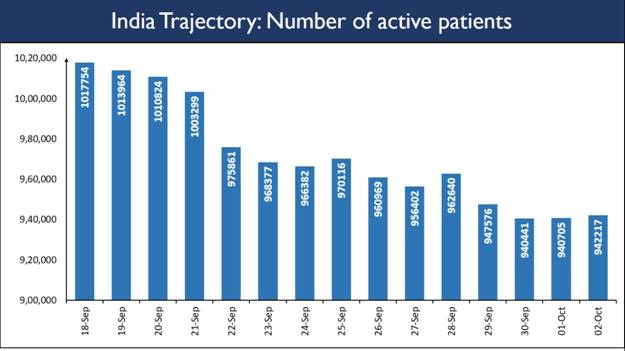
With a very high number of COVID patients recovering every single day, India’s steady trend of posting high level of daily recoveries also continues.78,877 recoveries have been registered in the last 24 hours in the country. This has resulted in continuous increase in the national recovery rate, which is currently pegged at 83.70%.
India’s total recoveries are 53,52,078 today. The last 10 lakh recoveries were added in just 12 days. With this, India continues to maintain its global position of being the country with maximum number of recovered COVID patients in the world.
76.62% of the active cases are in 10 States/UTs.
As on date, the active cases contribute only 14.74% to the positive caseload of the country. Maharashtra is leading the States’ tally with more than 2.5 lakh cases. Karnataka follows with more than 1 lakh cases.
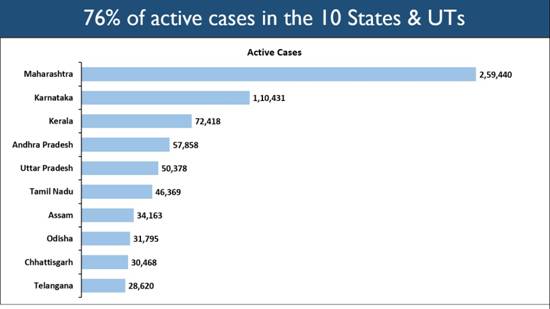
14 States & UTs in the country have less than 5,000 active cases.
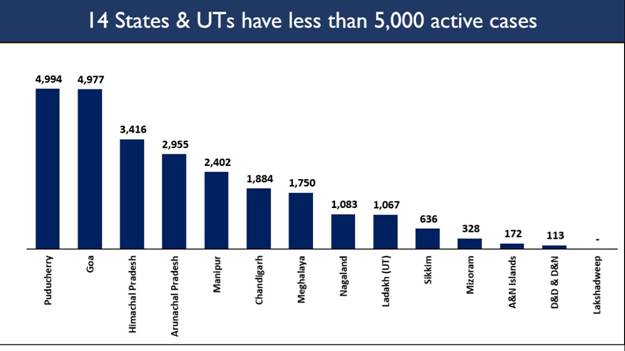
A total of 81,484 new confirmed cases have been reported in the last 24 hours in the country.
78.07% of the new cases are concentrated in ten States/UTs. Maharashtra contributed more than 16,000 to the new cases. Karnataka has contributed around 10,000 cases and Kerala follows with more than 8,000.
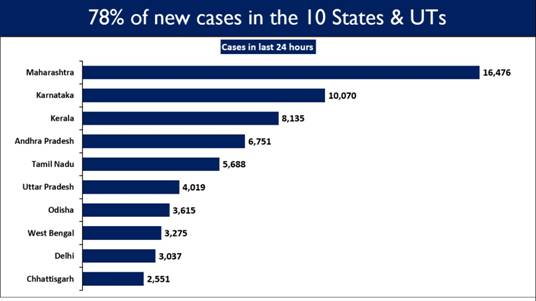
10 States/UTs account for 72% of the newly recovered cases.
Maharashtra has the highest number of newly recovered cases followed by Andhra Pradesh and Karnataka.
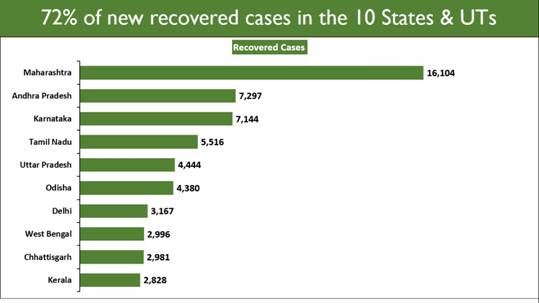
1,095 deaths have been registered in the country in the past 24 hours.
83.37% of these are reported from 10 States and UTs.
36% of deaths reported yesterday are from Maharashtra with 394 deaths, followed by Karnataka with 130 deaths.









































